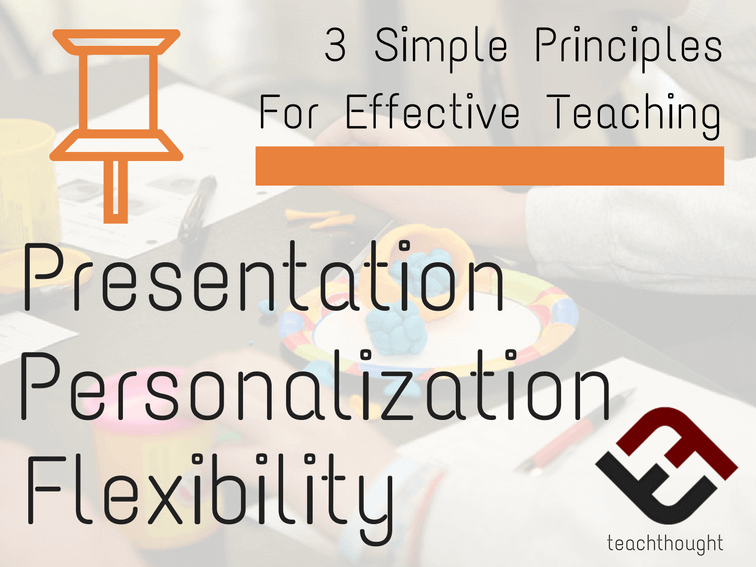
3 Simple Principles For Effective Teaching
by Barry Saide and Anna Hackelburg
The characteristics of good teaching is a popular topic in education, but it might be the case that we over-complicate the idea. If you think about it, good teaching and planning is not much different than ‘good eating.’
If we have a balanced instructional diet fostered by intentional planning in our classrooms, we will reach all of our different learners. Just as people want a variety of food in their diets and a variety of colors and flavors on their plates, students want a variety of teaching techniques and learning experiences at school. While routine provides the stability, structure, and comfort students need, innovative and effective practice demands we provide different ways to introduce and practice skills to ensure learning is occurring.
We all have our go-to comfort foods; macaroni and cheese, chicken fingers, hot dogs, or maybe chocolate chip cookies. But, if we ate those daily, they wouldn’t provide us the same feeling of comfort they do when we eat them during special times. If anything, eating the foods above would make us feel uncomfortable and tired as learners and/or teachers. they do when we eat them in addition to a variety of other meals and flavors.
The same goes for the classroom. Our students will crave the routine we create together in the beginning of the school year (especially special needs students), but as we plan lessons, we need to continue to extend and experiment with our pedagogical planning and implementation to continually provide for the ever-changing educational palette our students developmentally demonstrate in the classroom.
As younger educators, our first thought usually went toward content: the what of our teaching. What did the book tell us to teach? What did the curriculum say? This is similar to a chef preparing a steak without knowing whether their customer ordered steak, is allergic to steak, or is a vegetarian. Like a chef, a teacher must allocate their energy to multiple areas as they plan each meal.
Here are three ways we believe all educators can plan and teach with purpose:
1. Presentation
Any good meal needs to look appetizing. A lesson does, too. Time must be allocated in lesson planning toward making a lesson relevant to students by using student background knowledge, interests, and/or real world experiences. Time spent on an anticipatory set with relevance and readiness will engage students. When we overlook presentation prep time, it’s no different than being served your favorite steak and fixings on a garbage can lid.
2. Personalization
Every meal has an ideal temperature it must be cooked at and served at. Sometimes, those temperatures are not the same. Foods like steak must be allowed to rest for a few minutes prior to slicing or serving. Soups must be allowed to cool a bit, while fajitas tend to be sizzling when brought to a table. When lesson planning, we must take the temperature of the room as we present the anticipatory set. Do we need to adjust instruction by speeding our pace, or slowing down?
Have we embedded opportunities for students learning at different rates by using think-pair-share or turn and talk? Does our follow-up independent work include a menu of options to demonstrate understanding or mastery? We need to be careful of the way we deliver instruction. There’s a reason Gazpacho is served cold and flambe is on fire.
3. Flexibility
We’ve all been at restaurants, ordered food that sounded amazing, but did not live up to expectations. When that happens, we don’t take one for the team. We send it back to the kitchen and try a different meal.
The same is true for lesson planning. We can plan, plan, plan, and on paper the lesson looks and sounds amazing. But when it is time to implement, the lesson doesn’t go the way we’ve expected. It’s okay to send that lesson back, too. Forcing our students through a lesson that is falling apart isn’t good for anyone: they don’t like it and neither do we. It’s okay to abandon plans if they are better on paper than when in play.
Just as it might be hard to send an entree back to the kitchen because we don’t want to offend the chef, it may be difficult to come to terms that a lesson isn’t working. In the end, the chef will prepare a new meal, and we as educators will prepare a new lesson. This can be done on a different day and time, or we can keep a concept and give students a different way to experience it.
We find that some of our best teaching comes from an overall idea and end goal, and to make changes or adjustments as we go. We don’t over plan to the point where you have a script we follow. Planning for the experiences we want your students to have allows the rest to happen of the lesson to happen organically. And, isn’t organic the cleanest, freshest way to eat (and teach)?
As educators, we must always remember that our roles need to be a combination of art and science, much like a chef must balance the chemistry of meal creation with the pageantry of proper plating.
We wish you a “Bon Appetit” in your teaching and learning with students!
Barry Saide is currently the Supervisor of Curriculum and Instruction for Frelinghuysen School District in New Jersey. He was recognized in 2014 as an ASCD Emerging Leader. Connect with Barry on the ASCD EDge social network and on Twitter @barrykid1. Anna Hackelburg has been a teacher at Frelinghuysen Township Elementary School for 10 years. She graduated from Centenary University with a BA in psychology, special education degree, and k-5 certification.
3 Simple Principles For Effective Teaching
